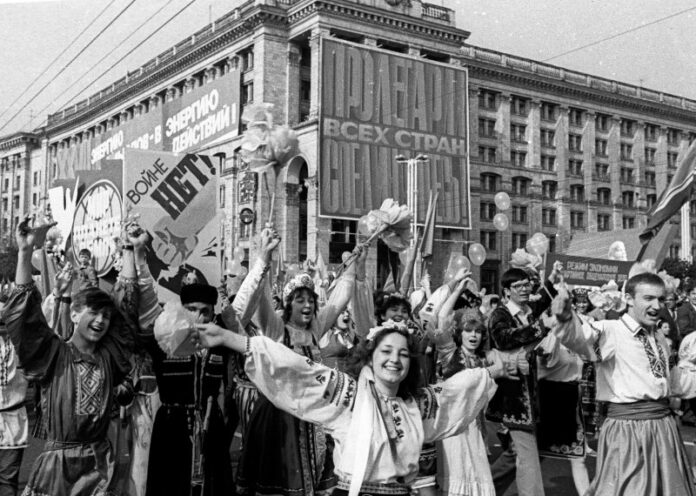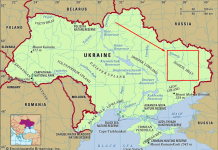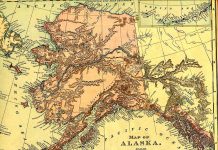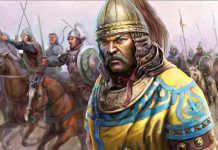
Adam Higginbotham in his prize-winning Midnight in Chernobyl writes the following:
“On Wednesday, April 30—the eve of the annual May Day celebrations, which would fill the streets of towns and cities throughout the USSR with parades and rallies—the wind blowing over the Chornobyl plant shifted once more. This time it turned almost due south, carrying energetic alpha and beta contamination directly toward Kyiv, along with dangerously high levels of gamma radiation, in the form of iodine 131—the radioisotope that concentrates dangerously in the thyroid gland, particularly in children. At exactly one o’clock that afternoon, radiation levels on the streets of the city began to rise abruptly. By nightfall, recorded radioactivity on Nauki Prospekt, near the heart of Kyiv on the eastern bank of the Dnieper, had reached as high as 2.2 milliroentgen per hour (or 22 microsieverts per hour)—hundreds of times higher than normal. The progress of the radioactive cloud had been tracked by the weather-monitoring equipment of the USSR State Committee for Hydrometeorology, which that day sent classified reports of its findings to Prime Minister Ryzhkov in Moscow, but also to the leaders of the Ukrainian Communist Party in Kyiv, including First Secretary Scherbitsky. Inside the Ukrainian Ministry of Health, the republic’s senior doctors, normally orderly and restrained, started to panic. They discussed the need to take precautions against radioactive aerosols and to broadcast a warning to the population. But they took no action. Valentin Zgursky, the chairman of the Kyiv City Executive Committee—the city mayor, also responsible for coordinating its civil defense—had worked at a factory manufacturing gamma measurement tools and was familiar with the dangers of radiation. He tried to convince Scherbitsky to cancel the big May Day parade they had scheduled to pass through the center of the city the following morning. But the first secretary told him that the orders had come down from Moscow. Not only would the parade take place, but they were all expected to attend and to bring their families with them—to demonstrate that there was no reason for anyone in Kyiv to panic.
The following morning, preparations for the parade got underway as usual. Party organizers had hung banners, and spectators filled the streets. At ten o’clock, the first secretary was scheduled to open the parade from his position in the center of the tall reviewing stand overlooking the Square of the October Revolution. But with only ten minutes to go, he was nowhere to be seen; his central spot on the platform remained empty.
The members of the Ukrainian Politburo, the city mayor, and the other assembled dignitaries became agitated: no one else but the first secretary had the right to start the procession, and he had never been late for the May Day parade in all his years in office. At last, his Chaika tore down the hill toward the rostrum and pulled up sharply. Scherbitsky climbed from the backseat, red-faced and cursing.
“I told him that we can’t possibly conduct the parade on Khreschatyk,” he muttered to the assembled dignitaries. “It’s not like Red Square. This is a ravine: there’s radiation pooling here. . . . He told me: You’ll put your Party card on the table if you bungle the parade.”
The furious first secretary left no one in any doubt about whom he had been speaking to. The only man in the Union with the authority to threaten him with expulsion from the Party was Gorbachev himself.
“To hell with it,” Scherbitsky said. “Let’s start the parade.”
Soon after ten o’clock, the cheering crowds began their march down the broad avenue of Khreschatyk. The sun was warm, the atmosphere festive. There were seas of red banners and biers of brightly colored peonies in spring shades of magenta, yellow, and blue; ranks of Party veterans clad in gray suits and scarlet sashes; the girls of the Young Pioneers—the Communist Girl Scouts—in white uniforms and red neckerchiefs, waving boughs of cherry blossom; and young dancers in the embroidered blouses and billowing sharovary pants of traditional Ukrainian Cossack dress, swinging arm in arm in extended lines or spinning in tight circles. Carrying their children or leading them by the hand, the citizens of Kyiv marched in dense blocks beneath the boulevard’s famous chestnut trees, clutching balloons and bearing placards depicting Soviet and Ukrainian Party leaders, past the fountains of the Square of the October Revolution, where six-story portraits of Marx, Engels, and Lenin gazed impassively from the grimy facades of the apartment buildings. Scherbitsky, who waved and smiled paternally from the rostrum as his subjects passed, had made some concessions to the perils of the fallout carried on the breeze: instead of four hours, the parade lasted only two; instead of between four thousand and five thousand people from every district, Party organizers gathered only two thousand. But the first secretary ensured that his grandson Vladimir participated in the march. Kyiv mayor Zgursky brought his three sons and two grandchildren. Some on the rostrum that morning had armed themselves with dosimeters and consulted them discreetly, but constantly. Others simply stole occasional glances at the sky.
Later, when the wind changed direction again, threatening to carry the plume of radionuclides north toward Moscow, Soviet pilots flew repeated missions to seed the clouds with silver iodide, designed to precipitate moisture from the air…”
National Review found the correct words to describe what Moscow did to Kyiv and Ukraine that day:
“Perhaps the worst example of total disregard for the truth and human lives came on May 1. Winds that had initially blown the radiation north and over the Scandinavian monitoring devices had turned and were keeping most of the increasing radiation over Ukraine, Belarus, and some areas within Russia. While this radiation continued to drop over the Ukrainian countryside, the Soviets staged their annual extravagant May Day parade in Moscow. Mikhail Gorbachev, whose leadership guided the Kremlin response, smiled and waved to the crowd in Red Square. To the south, just 90 miles from where the fires of Chornobyl were still burning out of control, the Soviets staged another massive parade in Kyiv that included children dancing down Kyiv’s broad central avenue, Khreshchatyk. Perhaps the only noticeable difference from previous May Day celebrations in Kyiv was the fact that as the marchers and dancers reached the reviewing stands where Communist Party bosses traditionally watched the festivities, they found the stands empty. Some members of the “classless” Soviet society had been given enough information to know to evacuate the republic’s capital. There was also a May Day bicycle race. Exercise and deep breathing — all the better to inhale radiation…
Given the lack of concern Gorbachev’s government showed for the population’s unnecessary exposure to the deadly Chornobyl radiation, the ordinary citizens of Ukraine might as well have been the “kulaks” Stalin sought to “liquidate as a class” in his intentional and forced famine of 1932–33. Their safety and health meant nothing. From Stalin to touted glasnost, what had changed?”









